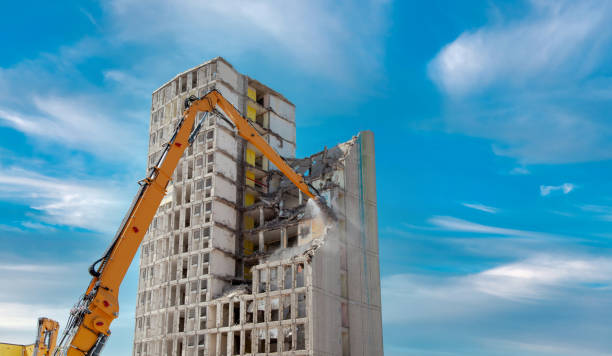When it comes to handling hazardous materials, commercial demolition contractors take a systematic approach that begins with identifying potential risks on-site.
You might wonder how they manage to ensure safety while removing substances like asbestos or lead-based paint.
They don’t just rely on standard practices; they develop detailed plans that encompass specialized equipment and techniques.
But what happens after the materials are safely removed?
Understanding the disposal process is crucial, and it raises questions about environmental responsibility and regulatory compliance that are worth exploring further.
Identifying Hazardous Materials
Recognize Potential Hazards:
- Common Hazardous Materials: Be aware of common hazardous materials found in commercial demolition projects, including asbestos, lead-based paint, and certain chemicals.
- Identify Warning Signs: Look for signs like peeling paint, old insulation, and storage containers that may contain hazardous materials.
Familiarize Yourself with Regulations:
- EPA and OSHA Guidelines: Adhere to the guidelines and regulations set forth by the Environmental Protection Agency (EPA) and Occupational Safety and Health Administration (OSHA) for the safe handling and disposal of hazardous materials.
- Professional Inspections: Consider hiring professionals for a thorough site inspection to identify and assess potential hazards.
Document Findings and Train Your Team:
- Maintain Records: Keep detailed records of all identified hazardous materials, including their locations and types.
- Train Your Team: Train your team to recognize and handle hazardous materials safely, fostering a culture of safety on the job site.
By diligently identifying and managing hazardous materials, you can ensure the safety of your workers and the environment during commercial demolition projects.
Safe Removal Procedures
Hazardous material removal is a critical task that necessitates meticulous planning and execution to ensure the safety of personnel and the environment.
Site Assessment and Material Identification
- Thoroughly assess the site to identify the presence and location of hazardous materials.
- Conduct a detailed inventory of all hazardous materials present, including their type, quantity, and condition.
- Consult relevant safety data sheets (SDS) for each material to understand its specific hazards and recommended handling procedures.
Develop a Removal Plan
- Create a detailed removal plan that outlines the specific procedures for handling each hazardous material.
- Identify and procure necessary personal protective equipment (PPE), such as respirators, gloves, protective suits, and eye protection.
- Establish clear lines of communication and designate roles and responsibilities for all personnel involved in the removal process.
Implement Safe Removal Techniques
- Contain the hazardous materials to prevent their spread during removal.
- Utilize appropriate engineering controls, such as ventilation systems, to minimize exposure.
- Follow established decontamination procedures to ensure that personnel and equipment are properly cleaned after exposure.
Maintain Communication and Safety Protocols
- Maintain regular communication among all personnel involved in the removal process.
- Conduct regular safety checks to ensure that all safety protocols are being followed.
- Address any safety concerns or incidents promptly and effectively.
By following these guidelines and prioritizing safety at every stage, you can effectively remove hazardous materials while minimizing risks to human health and the environment.
Proper Disposal Techniques
Proper disposal of hazardous materials is paramount for environmental protection and public health. As a commercial demolition contractor, adhering to strict guidelines is crucial.
Material Identification and Segregation
- Accurately identify all hazardous materials present, such as asbestos, lead paint, chemicals, and electronic waste.
- Segregate hazardous materials from regular demolition waste using clearly labeled containers.
- Consult relevant safety data sheets (SDS) to understand the specific handling and disposal requirements for each material.
Compliant Disposal Methods
- Partner with licensed hazardous waste disposal facilities that specialize in the safe and environmentally sound disposal of the identified materials.
- Ensure compliance with all local, state, and federal regulations regarding hazardous waste disposal.
Safe Transportation and Documentation
- Utilize appropriate transportation methods and protective gear to minimize the risk of spills or releases during transport.
- Maintain detailed records of the origin, type, quantity, disposal method, and final destination of all hazardous waste.
- Retain these records for future audits and compliance checks.
By diligently following these guidelines, commercial demolition contractors can ensure the safe and responsible disposal of hazardous materials, minimizing environmental impact and protecting public health.
Handling hazardous materials during commercial demolition projects requires a meticulous and systematic approach.
By effectively identifying and assessing potential hazards, developing and implementing safe removal procedures, and ensuring proper disposal techniques, commercial demolition contractors can minimize risks to human health and the environment.
Adhering to regulations, maintaining accurate records, and partnering with licensed disposal facilities are crucial for ensuring environmental responsibility and compliance.
This commitment to safety and environmental protection is essential for the successful and responsible execution of any commercial demolition project.
